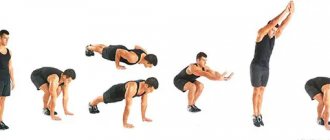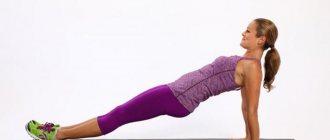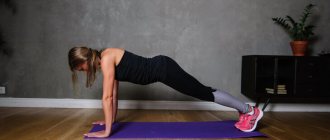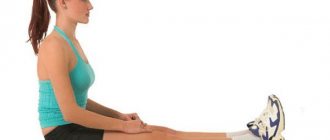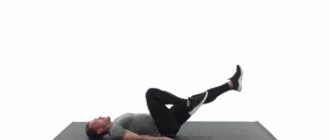What muscles does the mountain climber exercise use?
If we consider mountain climber exercises from the point of view of biomechanics, then we can draw a conclusion. That almost all muscles get a load. Only some of them work dynamically, directly performing the movement itself. Others act as stabilizers receiving a static load. Let's take a closer look at the role of muscles in this exercise.
- Abdominal muscles. These include: rectus abdominis
,
obliques
and
transverse abdominis
. All of them are responsible for stabilizing the pelvis, preventing it from sagging down. When it comes to climbing exercises, the first thing they talk about is the development of the abdominal muscles. - Leg muscles. Let's start from the bottom up. Bending the leg at the knee joint occurs due to contraction of the calf muscles
.
Next, the quadriceps
.
Especially long head. Due to its contraction, the leg bends at the hip joint and brings it to the chest. The hamstrings
and
gluteal muscles
are responsible for the reverse process. They extend the leg at the hip and knee joints. At the same time, the gluteus maximus acts as a pelvic stabilizer. - Back muscles. This includes almost all the muscles of this group. Diamond-shaped
and
trapezoidal,
work statically and are responsible for stabilizing the shoulder blades.
The lats
help
the back extensors
stabilize the spine.
The iliopsoas
muscles, together with the long head of the quadriceps, bend the leg at the hip joint. - Deltoid. In particular, the front and middle heads. They act as shoulder stabilizers.
- Pectoral muscles. Together with the deltoid, they stabilize the humerus. These include: the pectoralis major, pectoralis minor and serratus anterior muscles.
- Arm muscles. Triceps
and
biceps
. Responsible for stabilizing the elbow. They work statically.
As you can see, a very large number of muscles are involved in this exercise. Of course, by doing this, we will not be able to influence their size. But on the other hand, their strength and endurance will increase.
What does the “climbing” exercise do?
The “climber steps” exercise loads different muscle groups, so it can be considered not only effective, but also truly universal. If you follow the technique, training not only strengthens your abs, but also engages other muscles and helps keep them toned. The exercise allows you to:
- strengthen the deep muscles of the trunk, which provide stabilization of the spine;
- tighten your abs, legs and arms;
- maintain spinal health;
- get good posture;
- increase the elasticity of ligaments;
- compact bone tissue;
- intensively burn calories for weight loss;
- form a sculpted, beautiful press.
The benefit of the “climber” exercise also lies in the fact that with its help you can increase the vitality and endurance of the body, necessary for strong physical exertion.
Benefits of this exercise
- Performing this exercise allows you to increase the strength and endurance of the muscles of the whole body.
- With the help of the climbing exercise, you will strengthen your abdominal and back muscles. Which will make your waist look flatter. And it will improve your posture.
- Working at a fast pace can strengthen your cardiovascular system and overall endurance.
- By strengthening the back muscles, the risk of spinal injuries will decrease.
- To perform the climber exercise, no special equipment is required. What makes it accessible to everyone and gives the opportunity to train not only in the gym, but also at home.
- When performing a mountain climber, your metabolism increases and a large number of calories are burned. Therefore, this exercise will be indispensable for overweight people.
- The climber exercise is suitable for both beginners and more professional athletes. The main thing is to choose a pace and range of movement that is comfortable for you.
- This exercise has a very large variation in execution. Therefore, you can always diversify your training program and at the same time work your muscles from different angles.
As you can see, the list of advantages is very impressive.
Exercise rock climber
The “climbing” exercise for the abs is an extremely effective cardio exercise that helps strengthen the cardiovascular system and increases the overall endurance of the body.
With its help, if performed correctly, an athlete can get strong and aesthetically pleasing abs in a relatively short time. The basis of the exercise is the “plank” position, which engages the deep muscles and forces them to work with maximum efficiency. No additional equipment or sports equipment is required for classes.
Many athletes choose this exercise as a warm-up, as it allows them to quickly warm up their muscles and prepare for subsequent workouts.
Execution technique
If you look from the outside, the climbing exercise seems quite simple. Take a lying position and alternately pull your knees to your chest. But as soon as the athlete begins to perform it himself, the opinion changes radically. Before you begin the movement itself, you need to correctly adopt a lying position. In the modern world, this stance is better known as the PLANK EXERCISE. And many who tried to stand in it for even a minute know that this is not an easy task.
Initial position:
- Lie with your stomach down. Place your palms on the floor in line with your shoulders.
- As you exhale, straighten your arms and press your body up.
- Next, starting from the head, we tense the muscles one by one.
- The head should be an extension of the spine. That is, we do not lift it up or lower it until the chin touches the chest.
- The shoulder blades are spread apart and lowered down due to contraction of the serratus anterior muscle.
- The body does not hang on the shoulders. On the contrary, the deltoids are tense and the torso is raised up.
- Next, we tense the abdominal muscles: the rectus and external obliques. This way we will prevent the pelvis from falling forward.
- We also strain our gluteal muscles. They will pull the pelvis towards themselves, due to which the spine will straighten and it will be easier for us to tense the abdominal muscles.
- The legs are completely straight and rest on the floor with the tips of the toes. The feet can be placed next to each other, or placed shoulder-width apart.
- We check ourselves, the neck is straight, the muscles of the back, chest and shoulders are tense. The abs and buttocks are in static tension. Legs are straight.
- Our body from head to toe should form a straight line.
Performance:
- Exhale and lift one of your legs off the floor. In this case, the weight is evenly distributed over the 3 remaining support points. Two hands and one foot.
- By contracting the iliopsoas muscle and the long head of the quadriceps, we pull the leg towards the chest.
- Work within the range that your flexibility allows. Having brought the leg to the maximum, we inhale and distribute it, returning to the starting position.
- We do the same with the second leg.
How to make the exercise more effective
For advanced athletes, there are several options for performing the exercise that will increase performance. The complication should be carried out when 3-4 approaches of 30-40 times on each leg are performed easily and naturally - there is no point in increasing the number of repetitions, it is better to add new elements.
With expander
Resistance bands on the legs will help increase the force with which the abdominal muscles will pull the leg. This will work out your abdominals, buttocks and thighs much better. Suitable for the classic version, crosswise, side and other variations.
On slings or bench
Suitable for those who work out in the gym or have a wall bars at home for attaching loops. In the initial position, the legs are not on the ground, but in the air, fixed in rings, loops or other devices. This way, increased load will be placed on the shoulder girdle, abs and back muscles. The technique remains the same as in the classic version.
The hinges can be replaced by a regular bench. The load will increase in proportion to the height of the legs raised above the floor.
With sliders or sliding “climber”
To set the maximum pace, you will need special sliders or another sliding object. They are placed on the legs and increase resistance, causing the abdominal muscles to work harder.
On one hand
To simultaneously work the abs, arm muscles, and shoulder girdle, you can perform the exercise with emphasis on only one arm, with the other placed behind your back. The technique is exactly the same as in the classic version, with twisting or lateral abduction of the leg. It is worth considering that with an increase in the load on the shoulders, the effectiveness of working out the abs will decrease.
With weights
Special leg weights for fitness can create additional load and increase the effectiveness of the exercise. You can buy them at any sports store. You shouldn’t start with a lot of weight right away; you should add additional grams and kilograms after you have completely mastered the previous ones.
Recommendations for implementation
- When performing, you need to be as focused as possible on the work of the target muscles. From tension of the rectus and oblique abdominal muscles, to contraction of the quadriceps when bending the leg.
- When performing the exercise, the pelvis must be fixed. There is no need to lift it up or down when bending your legs.
- Keep your back and buttock muscles constantly tense. This will prevent your pelvis from sagging.
- When performing the classic version, your arms should be completely straight. If you keep them half-bent, then a greater load will fall on the triceps and biceps. And their fatigue can occur faster than the abdominal muscles.
- If you experience pain in your wrists while performing. Then you can use small dumbbells as a support. Place them on the floor, perpendicular to each other, and grasp them with your hands. Or take a fist stand.
- It is best to perform the exercise in shoes with rubber soles. This will prevent your feet from sliding on the floor.
How to Incorporate the Climber Exercise into Your Workout
Instead of jumping on the treadmill or rowing machine to warm up, position yourself on the floor and perform 30 to 50 reps of mountain climbers. Because these moves are a full-body workout, you'll be ready for almost any workout.
Another option: practice Tabata style. Tabata is a high-intensity workout that involves performing 8 rounds of 20 seconds with 10 seconds rest between rounds. Trust me: when the 4 minutes are up, you will know what real, hard work feels like.
As a substitute for high-intensity training, try 20 minutes of circuit training for men and women.
Exercise options
As mentioned earlier in the article, the rock climber exercise has a large number of execution options. Depending on how you make the movement, the emphasis of the load on certain muscles changes.
Climber exercise with hands resting on a hill
To perform this option, you will need some kind of elevation. This could be: a step platform, a horizontal bench press, or a chair without a back if you train at home. This option is perfect for beginner athletes. By changing the angle of inclination upward, the press will be slightly unloaded. Because for us, it is more natural to be in an upright position. At the same time, the load on the gluteal muscles will increase. Otherwise, the principle of performing the exercise is exactly the same. Get into a plank position with straight arms. Only now we rest our palms not on the floor, but on a bench or chair. And we bend our legs one by one, pulling them to the chest.
Climber exercise standing on elbows
This option will relieve stress on your arms and shoulders. Giving you the opportunity to concentrate as much as possible on working the muscles of the abdominal cavity, pelvis, legs and back. Since we are now standing on our elbows, our body will be located much lower. And bringing a bent leg will be much more difficult. Therefore, we will have to move the hip to the side a little. And now we will lead the leg not to the chest, but to the elbow. Due to this technique, additional load will fall on the oblique abdominal muscles.
Side Twist Climber
Performing this option will shift the emphasis on the oblique abdominal muscles. It is perfect for athletes who want to reduce their waistline. Girls really like to do it. But this does not mean that this option is not suitable for men. In order to get that same twist, you need to pull your leg towards the opposite elbow. For example, the left knee to the right hand and vice versa. There is no need to further expand the body while driving. This will not affect the effectiveness of the exercise in any way.
Climber exercise with emphasis on the ball
You can use any ball, as long as it is hard. A medicine ball with special handles on which the palms are placed is also perfect. Due to this, the load on the wrists is reduced. This option is designed to develop coordination and helps to load smaller stabilizer muscles. Also, at the moment of lifting the leg, the abdominal muscles are additionally activated. Without giving us the opportunity to fall to the side.
Reverse climber
This type of climber exercise is less common than others. To perform it, we need to take a plank pose with our backs down. That is, now we rest on the floor with the heels of our feet, and not with our toes. In this pose, the load shifts to the muscles of the legs and pelvis. The abs are also tense. But his role is becoming significantly smaller. Raising your leg will be much more difficult. Therefore, the quadriceps and iliocostalis muscles will have to turn on at full capacity. The principle of implementation is this. Take a plank pose with your back down. The body should be straight, from the heels to the crown. As you exhale, bend your leg and pull it up towards the pectoral muscles. As you inhale, lower it and do the same on the second leg.
Bipedal climber
This option is the most difficult of the above. To perform it, you need to have very strong arms and shoulders. So that we can control the weight of the body at the moment the legs lift off the ground. This option is aimed at working the rectus abdominis muscle. It's worth doing it at a fast pace. The technique is slightly different from the classic version. We stand point-blank lying on straight arms. We take a breath and jump up a little. At the same time, by contracting the rectus abdominis and quadriceps muscles, we bend our legs and slightly twist our pelvis forward. As soon as we land on our toes, immediately while inhaling we do a reverse jump and return our legs to their original position.
Techniques and recommendations
The climbing exercise is used, as a rule, by trained athletes. But if you are new to fitness, we recommend that you familiarize yourself with the features of the element. Classic technique:
- Lower yourself into a plank position with your arms straight.
- Tighten your core muscles (hips, buttocks, abs).
- Sharply pull your knee towards your stomach, but do not place your toe on the floor.
- With the same quick movement, take your leg back to the starting position and at the same time lift the opposite knee towards you.
Recommendations:
- Move without pausing. The exercise should resemble horizontal running.
- Avoid sagging in the lumbar region or, conversely, rounding your back.
- When doing this, keep your arms straight and your head down so as not to strain your neck.
- Try to move only your legs. The body and pelvis must remain motionless.
- The exercise is performed at a fast pace for a while. Beginners should start with 15 seconds per set and gradually work their way up to 1 minute.
The classic version of the “climber” is aimed at maintaining leg muscles in tone, as well as losing weight. If you want to load your abs better, perform the element at a slow pace. The technique will be like this:
- Take an emphasis lying on straight arms.
- Tighten your abdominal muscles and buttocks.
- Exhale and smoothly pull your knee towards you, while inhaling, move your leg back to the starting position.
- Do the same with the other limb.
Recommendations:
- Keep your body in one line.
- Avoid swinging your body to the sides.
- Keep your arms straight.
- The exercise should be done for 3-4 sets of 12-15 repetitions.
Contraindications to the element:
- severe cardiovascular diseases;
- pregnancy;
- recovery period after abdominal surgery;
- untreated knee injuries;
- ankle sprain.
Tips for maximum efficiency
- The classic version can be performed at a fast pace. From the outside it will resemble horizontal running in place. This technique can be used at the end of a workout, thereby replacing a little cardio before starting a COOL-DOWN.
- If you want to increase the intensity of this exercise even more. Then you should use weights with sand or a rubber expander. If you train at the gym, you can attach your legs to the crossover cable.
- In order to further load the abdominal muscles, you can use the principle of “pre-exhaustion”. That is, first we do classic crunches while lying on the floor. Thus, we tire the abdominal muscles. And then we perform a climber. Finishing off already tired muscles.
- Beginner athletes can perform the climbing exercise in a jumping style. The principle is the same as in the two-legged version. Only we alternate each leg. This technique will help the muscles and ligaments adapt to movement.
- Be sure to work on the flexibility of your muscles and joints. This will allow you to work at full range.
- If you find it difficult to maintain a stable body position while performing the exercise. Then you should start mastering with a regular PLANK. Doing this will strengthen your muscles and make it easier for you to control your balance.
The climber exercise can be very effective if you adhere to the execution technique. For greater results, it is worth performing it in combination with other exercises for the abdominal muscles. It is also extremely important to increase the intensity by moving from simple to more complex options. And believe me, your muscles will just burn.
Good luck to everyone in your training!
Technique: how to do it correctly, what to look for, common mistakes
As already mentioned, in order to perform the “Climber” exercise without errors, you need to perform the plank correctly and stand in this position for at least 1-2 minutes.
If a beginner still has problems with this exercise, then first you need to adjust the technique and accustom the body to this load. Only after this can you begin to perform horizontal running.
To perform the “Climber” element, follow the instructions:
- Prop yourself on your hands and toes and fully straighten your upper limbs. Make sure your palms are opposite each other and your legs are at pelvic level.
- Stand so that your back, buttocks, and legs form one line. Tighten the muscles of your abdomen, sides, lower back, and glutes.
- Exhale, begin to bend your left leg at the knee, while simultaneously pulling it as close to your chest as possible.
- The toe can touch the floor or move it in the air.
- When your knee is as close to your chest as possible, hold for 2-3 seconds.
- As you exhale, return your left limb back. Then repeat the exercise for your right leg.
At first, hone your technique, perform the movement slowly to remember the sequence of actions. Over time, the pace of movement can be increased by quickly changing legs, pulling one or the other knee to the chest.
Important! Regardless of the pace of the Climber, the athlete must control the position of the torso and buttocks. This is a very important nuance that affects the load efficiency.
The duration of the workout is from 30 seconds to 1 minute twice or thrice with a break of no more than 1 minute. The main thing is to choose a comfortable speed that will not affect your technique. Over time, the duration of execution and the number of sets can be increased.
To perform the element correctly, you need to take into account common mistakes:
- Deflection of the lower back, lifting of the pelvis upward. When the spine bends, the static load on the abdominal muscles decreases. In addition, it is fraught with back injuries.
- Movement of the upper body. So, beginners try to reduce the load, then the target muscles do not work at full strength.
- Incorrect head position. Some athletes lower or raise their head excessively, but it should form one line with the body. Thus, the load on the cervical segment of the spine is reduced.
- Raising your arms beyond shoulder level. By moving the palms forward, the athlete increases the load on the shoulder joints.
- Rotation of the pelvis while lifting the lower limbs. You need to move your legs in the plane of your torso in order to maximally load your abs.
- Touching your knees to the floor. When lifting, you need to keep your leg in the air to work your abdominal muscles.
To support the lower back and avoid injury, the athlete must shift the load to the muscles of the abdomen and buttocks. Work at a slow pace at first, focusing on lifting your legs and positioning your body. Try to look at the floor while moving so that your neck is positioned correctly. The arms should be fully straightened; when they are slightly bent, the load on the abdominal muscles is reduced.
Be sure to check out:
Learning to restore breathing after physical activity: useful exercises Basic exercises for all muscle groups: a strong and strong body at home Jumping on a trampoline: effective for losing weight How to maintain excellent physical shape after 40 years: choosing exercises
Exercise Climber
The climbing exercise has nothing in common with mountain climbers, despite the similar name. It came to CrossFit from aerobics, and, despite its multi-joint nature, is not considered basic. In particular, it is mainly used as:
- warming;
- training the abdominal muscles;
- as aerobic or cardio.
Note: if additional weights are used, it may well be considered as basic.
But with the correct technique, it can amaze even an experienced athlete with its load. What is the secret of the climbing exercise, and who is it intended for?
Interesting fact: the exercise was successfully used by athletes and dancers during the Soviet school of sports. In particular, it was used as a simplified form of burpee, and the main task was not to prepare the abdominal muscles and leg flexors, but quite the opposite. The exercise, performed at a high tempo, was supposed to increase the strength endurance of future athletes, and most importantly, strengthen the arms and upper shoulder girdle for static load. It was then used in conjunction with exercise balls to improve coordination and prepare the obliques. And only with the advent of CrossFit as a sports revolution, the “climber” acquired its modern form.
Execution Variations
There are several main types of exercise. Each of which is a more complex version of a simple "climber".
- Bipedal climber - allows you to shift the load on your legs and use your heart muscles more strongly.
- Climber with body rotation - maximum load on the abdominal muscles and core.
- The Bent Climber is an extreme option for those who want powerful front deltoids.
- Climber with a load - helps to work out all muscle groups more strongly, in addition, develops explosive speed, useful when running.
Let's consider the technique of each of them as they become more complex.
Bipedal climber
The two-legged climber is designed to take stress off the obliques. Instead, the leg muscles are additionally trained for explosive strength.
How to do it correctly? Everything is very simple (but this does not mean that the exercise is simple):
- Take a lying position - hands are above head level, parallel to each other with a wide grip).
- Maintain a slight deflection in the body (no more than 10 degrees).
- At a fast pace (jumping style), pull both legs towards the body, and then return them to their previous position at the same pace.
In fact, in this case, the athlete imitates the movement of a frog, and a high pace and full use of the leg muscles increases the heart rate compared to a simple climber by approximately 25-30%.
Note: When working with this style of exercise, it is recommended to use a heart rate monitor in order not to exceed the maximum allowable heart rate. Since if it is exceeded, the benefit from the exercise is offset by the increased load on the heart, which, when working at a certain heart rate, receives microtraumas leading to the “sports heart” syndrome.
Climber with body rotation
This is another variation of the exercise that significantly reduces the load on the leg muscles, while maximizing the use of the core and abdominal muscles, especially the oblique and lateral abdominal muscles.
How to do it correctly?
- Take a lying “grasshopper” position - your hands are located significantly below shoulder level with your palms placed narrowly.
- Align the body.
- At a fast pace, pull one leg up, touching your knee to the body.
- At the moment of pulling your leg, turn your body in the direction of the turn.
- Stay in this position for about 5-10 seconds.
- Rotate the body to the starting position with the return of the leg.
In this case, it is considered that the climbing exercise is performed for the abs . Therefore, it can be used in combination with burpees, or with other sets of exercises that involve the oblique and lateral abdominal muscles.
To complicate the exercise, additional professionals, when turning the body, extend their arm upward, leaving their weight on the 1st leg and 1st arm. In this case, additional emphasis is formed in the athlete's deltas.
Climber with bent arms
This variation is almost identical to the classic exercise with the exception of one small nuance. To maximize the load on the deltoids and triceps, the arms in the starting position do not rest on the joints, but are slightly bent (as in the first phase of push-ups) and remain in this position until the end of the approach. This increases the load on the entire shoulder girdle and makes the exercise technically difficult.
